

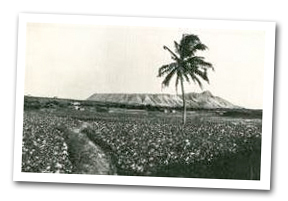 In early Hawaii, Waikiki was a much larger area
than the 1.5 square miles it encompasses today.
Old Waikiki, much of it swampland, included the
neighboring valleys of Manoa and Palolo. Translated,
Waikiki means "spouting water," a reference to the
rivers and springs that richly flowed into the area.
It's said that in the 1400s, Chief Kalamakua designed
an irrigation system to take advantage of Waikiki's
abundant resources. Fishponds were built and taro
patches were planted. In the 1450s, Waikiki was
established as the governmental center of Oahu.
In early Hawaii, Waikiki was a much larger area
than the 1.5 square miles it encompasses today.
Old Waikiki, much of it swampland, included the
neighboring valleys of Manoa and Palolo. Translated,
Waikiki means "spouting water," a reference to the
rivers and springs that richly flowed into the area.
It's said that in the 1400s, Chief Kalamakua designed
an irrigation system to take advantage of Waikiki's
abundant resources. Fishponds were built and taro
patches were planted. In the 1450s, Waikiki was
established as the governmental center of Oahu.
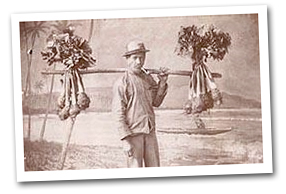 Waikiki was the setting for one of Hawaii's historic battles. In 1794, Kamehameha I arrived from the Big Island with a
fleet of canoes. His army stormed Waikiki Beach and then set out for Nuuanu to take on Oahu chief Kalanikupule and his
men. Kamehameha's forces proved superior, and the Oahu warriors were forced to retreat up the valley, where they were
pursued and driven off the steep Pali cliffs to their deaths. Waikiki was the setting for one of Hawaii's historic battles. In 1794, Kamehameha I arrived from the Big Island with a
fleet of canoes. His army stormed Waikiki Beach and then set out for Nuuanu to take on Oahu chief Kalanikupule and his
men. Kamehameha's forces proved superior, and the Oahu warriors were forced to retreat up the valley, where they were
pursued and driven off the steep Pali cliffs to their deaths.
 Oahu and other Hawaiian islands were first discovered by Europeans on January 18, 1778, when British explorer Captain James
Cook landed on Kauai, Hawaii's fourth largest island. Honolulu began as a small harbor village established by foreign fishermen
in the early 1800s. The area soon flourished into an important center as it provided a resting spot for merchant ships trading
furs with the east and for fishing and whaling ships in the area. The waterfront area played a vital role in the history of Honolulu.
King Kamehameha I moved his royal court here in 1809 to keep an eye on the burgeoning trade from the numerous ships that were coming here.
Oahu and other Hawaiian islands were first discovered by Europeans on January 18, 1778, when British explorer Captain James
Cook landed on Kauai, Hawaii's fourth largest island. Honolulu began as a small harbor village established by foreign fishermen
in the early 1800s. The area soon flourished into an important center as it provided a resting spot for merchant ships trading
furs with the east and for fishing and whaling ships in the area. The waterfront area played a vital role in the history of Honolulu.
King Kamehameha I moved his royal court here in 1809 to keep an eye on the burgeoning trade from the numerous ships that were coming here.
In the mid to late 1800s, Waikiki served as a vacation retreat for the kingdom's royalty. Kamehameha IV, Kamehameha V,
Lunalilo, Kalakaua, Liliuokalani and Princess Kaiulani were among the dignitaries who maintained residences in the area,
enjoying moonlight horseback rides, thrilling canoe races and carefree romps in the ocean.
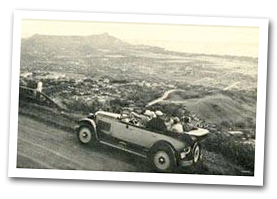 Foreign visitors began to visit Waikiki in the 1830s. A road was constructed in the 1860s, and a tramway and tramcars were
introduced in the late 1880s. After annexation, and in anticipation of an increase in visitors, the Moana Hotel was opened in 1901. Foreign visitors began to visit Waikiki in the 1830s. A road was constructed in the 1860s, and a tramway and tramcars were
introduced in the late 1880s. After annexation, and in anticipation of an increase in visitors, the Moana Hotel was opened in 1901.
In the late 1800s, the United States began to realize the strategic military importance of the Hawaiian islands, establishing
military bases at Pearl Harbor and central Oahu. With the installment of the U.S. military, the tourism business began to grow
in the Waikiki area.
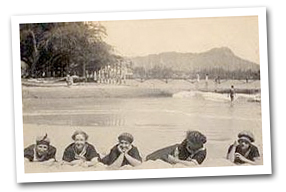 In anticipation of a growing tourism industry, the first luxury-trade hotel, the Moana Surfrider, was opened
in 1901 to accommodate wealthy European guests. Simultaneously, the territorial government in 1907, under what it called the "Waikiki Reclamation Commission," planned for
greater commercial and tourism development by widening streets, building bridges, and draining the duck ponds, rice paddies,
and taro patches that formed Waikiki's aquaculture.
In anticipation of a growing tourism industry, the first luxury-trade hotel, the Moana Surfrider, was opened
in 1901 to accommodate wealthy European guests. Simultaneously, the territorial government in 1907, under what it called the "Waikiki Reclamation Commission," planned for
greater commercial and tourism development by widening streets, building bridges, and draining the duck ponds, rice paddies,
and taro patches that formed Waikiki's aquaculture.
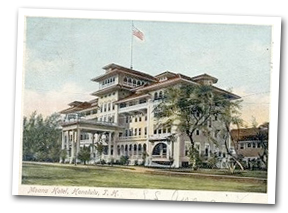 A new era begins. On March 11, 1901 Waikiki began a climb to global recognition as a tourist destination with the building of its first historic
architectural treasure The Moana Hotel. Built by the wealthy Honolulu landowner, Walter Chamberlain Peacock, The Moana Hotel had 75 guest rooms
that were the height of fashion for the day, offering spacious accommodations, telephones and private baths, a billiard room, parlor, library,
salon and the first electric-powered elevator in the Territory. These were true innovations for the times. It was and is the only resort in Hawaii
that reflects the Beaux-arts design of the early 1900's. A new era begins. On March 11, 1901 Waikiki began a climb to global recognition as a tourist destination with the building of its first historic
architectural treasure The Moana Hotel. Built by the wealthy Honolulu landowner, Walter Chamberlain Peacock, The Moana Hotel had 75 guest rooms
that were the height of fashion for the day, offering spacious accommodations, telephones and private baths, a billiard room, parlor, library,
salon and the first electric-powered elevator in the Territory. These were true innovations for the times. It was and is the only resort in Hawaii
that reflects the Beaux-arts design of the early 1900's.
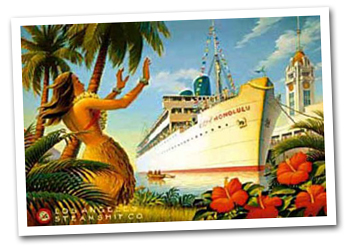 In 1920 the Waikiki landscape undergoes a dramatic re-development ushering in a new age of urbanization for Waikiki. The wetlands are declared a
health hazard and are drained by the construction of the Ala Wai Canal which was completed in 1928. The lands are reclaimed and subdivided into
5000 square foot lots. This real estate development turns rural Waikiki into a suburb. At the very heart of this suburb was the
Moana Hotel,
with all its grandeur, offering guests true respite and rejuvenation. In 1920 the Waikiki landscape undergoes a dramatic re-development ushering in a new age of urbanization for Waikiki. The wetlands are declared a
health hazard and are drained by the construction of the Ala Wai Canal which was completed in 1928. The lands are reclaimed and subdivided into
5000 square foot lots. This real estate development turns rural Waikiki into a suburb. At the very heart of this suburb was the
Moana Hotel,
with all its grandeur, offering guests true respite and rejuvenation.
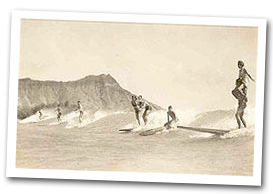 1927 sees the creation of new recreational opportunities for –destination Waikiki” with the building of the historic Waikiki Natatorium War
Memorial and the Honolulu Zoo. The Waikiki Natatorium War was a massive 100 yard by 40 yards wide Olympic swimming pool. It was unique because
it was actually on the beach and fed by ocean water. Several medal winning Olympians brought fame to this architectural wonder beginning with
Hawaiian Olympian Duke Kahanamoku (also made famous during this time by introducing the world to the modern sport of surfing) and joined by
other world renowned swimmers such as Fred Kono, Dick Cleveland, Johnny Weismuller and Buster Crabbe. The Honolulu Zoo is built on 40 acres
of Queen Kapiolani and is made part of the queen's trust. With the advent of these activities, The Moana Hotel stood as ground central for
tourists who visited these exciting new attractions.
1927 sees the creation of new recreational opportunities for –destination Waikiki” with the building of the historic Waikiki Natatorium War
Memorial and the Honolulu Zoo. The Waikiki Natatorium War was a massive 100 yard by 40 yards wide Olympic swimming pool. It was unique because
it was actually on the beach and fed by ocean water. Several medal winning Olympians brought fame to this architectural wonder beginning with
Hawaiian Olympian Duke Kahanamoku (also made famous during this time by introducing the world to the modern sport of surfing) and joined by
other world renowned swimmers such as Fred Kono, Dick Cleveland, Johnny Weismuller and Buster Crabbe. The Honolulu Zoo is built on 40 acres
of Queen Kapiolani and is made part of the queen's trust. With the advent of these activities, The Moana Hotel stood as ground central for
tourists who visited these exciting new attractions.
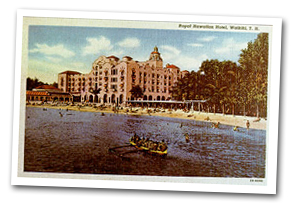 The Royal Hawaiian Hotel, a $4 million investment by the Matson Navigation Co. also opened on February 1, 1927. Built on 15 acres of beautiful beach frontage,
the luxurious hotel, with its distinctive Moorish-style architecture painted pink, was promoted world-wide as a premier visitor destination.
Elaborate opening ceremonies and festivities included dinner and dancing, a concert, and a pageant. What made Waikiki so attractive in the past contributed
to making the "Pink Palace" a favorite of both visitors and local residents for decades. The Royal Hawaiian Hotel, a $4 million investment by the Matson Navigation Co. also opened on February 1, 1927. Built on 15 acres of beautiful beach frontage,
the luxurious hotel, with its distinctive Moorish-style architecture painted pink, was promoted world-wide as a premier visitor destination.
Elaborate opening ceremonies and festivities included dinner and dancing, a concert, and a pageant. What made Waikiki so attractive in the past contributed
to making the "Pink Palace" a favorite of both visitors and local residents for decades.
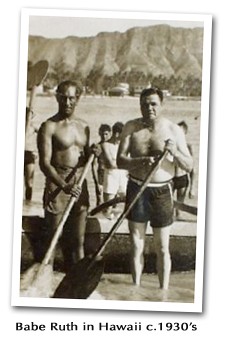 The rise of hapa-haole marks the beginning of Waikiki moving into full swing. The year was 1934 and Hawaiian music gains worldwide
popularity. It begins when Harry Owens and his big band became icons of popular Hawaiian music, followed by the launching of the popular
worldwide radio show Hawaii Calls. The show was actually broadcast from the courtyard of the Moana Hotel from 1935 until 1975 and a hallmark
of the show was the sound of the waves breaking in the distance. The rise of hapa-haole marks the beginning of Waikiki moving into full swing. The year was 1934 and Hawaiian music gains worldwide
popularity. It begins when Harry Owens and his big band became icons of popular Hawaiian music, followed by the launching of the popular
worldwide radio show Hawaii Calls. The show was actually broadcast from the courtyard of the Moana Hotel from 1935 until 1975 and a hallmark
of the show was the sound of the waves breaking in the distance.
Many new stars were created in Waikiki, including Hilo Hattie, Andy Cummings,
Alfred Apaka and Sterling Mossman. Visiting celebrities such as Bing Crosby, Shirley Temple, Groucho Marx, Clark Gable and Carol Lombard graced
Waikiki and many such as Frank Sinatra, Joe DiMaggio and Amelia Earhart stay at the Famous Moana, sealing its reputation as a first class destination.
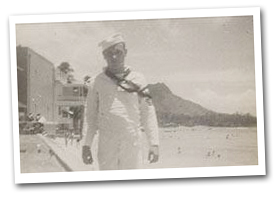 In 1941 the bombing of Pearl Harbor and the Second World War interrupts the flow of tourists
to Waikiki. It becomes a rest and recreation area
for soldiers and sailors coming and going to the war in the Pacific. Waikiki become the last stop for those heading to war not knowing if
they will come back and it's the first stop on American soil on their way back. From 1941-1945 The Moana Hotel transforms into a respite for
these soldiers, offering hospitality and friendship as they ventured into the unknown to fight for their country. In 1941 the bombing of Pearl Harbor and the Second World War interrupts the flow of tourists
to Waikiki. It becomes a rest and recreation area
for soldiers and sailors coming and going to the war in the Pacific. Waikiki become the last stop for those heading to war not knowing if
they will come back and it's the first stop on American soil on their way back. From 1941-1945 The Moana Hotel transforms into a respite for
these soldiers, offering hospitality and friendship as they ventured into the unknown to fight for their country.
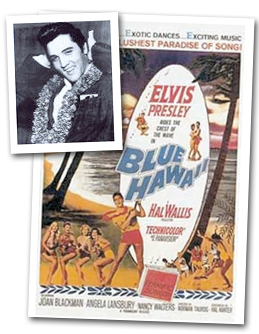 Tourism thrived during the late 1940'sand 1950's with the introduction of regularly scheduled airline services from the west coast and the Moana
became the jewel of Honolulu society. Celebrities such as Elvis Presley were regulars on the island and three of his films were shot on location on
Oahu, including on Waikiki Beach. Tourism thrived during the late 1940'sand 1950's with the introduction of regularly scheduled airline services from the west coast and the Moana
became the jewel of Honolulu society. Celebrities such as Elvis Presley were regulars on the island and three of his films were shot on location on
Oahu, including on Waikiki Beach.
Today, Waikiki is in full bloom. There are world-class hotels with familiar names like Hilton, Sheraton and Hyatt, and
there are smaller operations that still provide plenty of aloha. Waikiki also boasts Waikiki Beach and the iconic slopes of
Diamond Head Crater. There's 500-acre Kapiolani Park, the Waikiki Aquarium, Honolulu Zoo and the International Marketplace
(a shopper's bonanza located in the heart of Waikiki). Waikiki is also home to some of Hawaii's finest restaurants and hottest nightspots. Tourism is high, where companies like Blue Hawaiian Helicopters are offering tours around the island year round.
Best of all, everything is within walking distance. Waikiki is yours to discover, block by block, beach by beach. Welcome to the playground.
INSIDER'S GUIDE
History of Waikiki
The New Waikiki
How's the Weather
Traveler's Tips
Top 10
FAQ's
Local Flavor
Weddings
Honeymoons
Best Spas
Conventions
Golf in Hawaii
Beyond Waikiki
Have a question? E-mail
us and we'll do our best to answer you.
|











 In early Hawaii, Waikiki was a much larger area
than the 1.5 square miles it encompasses today.
Old Waikiki, much of it swampland, included the
neighboring valleys of Manoa and Palolo. Translated,
Waikiki means "spouting water," a reference to the
rivers and springs that richly flowed into the area.
It's said that in the 1400s, Chief Kalamakua designed
an irrigation system to take advantage of Waikiki's
abundant resources. Fishponds were built and taro
patches were planted. In the 1450s, Waikiki was
established as the governmental center of Oahu.
In early Hawaii, Waikiki was a much larger area
than the 1.5 square miles it encompasses today.
Old Waikiki, much of it swampland, included the
neighboring valleys of Manoa and Palolo. Translated,
Waikiki means "spouting water," a reference to the
rivers and springs that richly flowed into the area.
It's said that in the 1400s, Chief Kalamakua designed
an irrigation system to take advantage of Waikiki's
abundant resources. Fishponds were built and taro
patches were planted. In the 1450s, Waikiki was
established as the governmental center of Oahu. Waikiki was the setting for one of Hawaii's historic battles. In 1794, Kamehameha I arrived from the Big Island with a
fleet of canoes. His army stormed Waikiki Beach and then set out for Nuuanu to take on Oahu chief Kalanikupule and his
men. Kamehameha's forces proved superior, and the Oahu warriors were forced to retreat up the valley, where they were
pursued and driven off the steep Pali cliffs to their deaths.
Waikiki was the setting for one of Hawaii's historic battles. In 1794, Kamehameha I arrived from the Big Island with a
fleet of canoes. His army stormed Waikiki Beach and then set out for Nuuanu to take on Oahu chief Kalanikupule and his
men. Kamehameha's forces proved superior, and the Oahu warriors were forced to retreat up the valley, where they were
pursued and driven off the steep Pali cliffs to their deaths.  Oahu and other Hawaiian islands were first discovered by Europeans on January 18, 1778, when British explorer Captain James
Cook landed on Kauai, Hawaii's fourth largest island. Honolulu began as a small harbor village established by foreign fishermen
in the early 1800s. The area soon flourished into an important center as it provided a resting spot for merchant ships trading
furs with the east and for fishing and whaling ships in the area. The waterfront area played a vital role in the history of Honolulu.
King Kamehameha I moved his royal court here in 1809 to keep an eye on the burgeoning trade from the numerous ships that were coming here.
Oahu and other Hawaiian islands were first discovered by Europeans on January 18, 1778, when British explorer Captain James
Cook landed on Kauai, Hawaii's fourth largest island. Honolulu began as a small harbor village established by foreign fishermen
in the early 1800s. The area soon flourished into an important center as it provided a resting spot for merchant ships trading
furs with the east and for fishing and whaling ships in the area. The waterfront area played a vital role in the history of Honolulu.
King Kamehameha I moved his royal court here in 1809 to keep an eye on the burgeoning trade from the numerous ships that were coming here. Foreign visitors began to visit Waikiki in the 1830s. A road was constructed in the 1860s, and a tramway and tramcars were
introduced in the late 1880s. After annexation, and in anticipation of an increase in visitors, the Moana Hotel was opened in 1901.
Foreign visitors began to visit Waikiki in the 1830s. A road was constructed in the 1860s, and a tramway and tramcars were
introduced in the late 1880s. After annexation, and in anticipation of an increase in visitors, the Moana Hotel was opened in 1901. In anticipation of a growing tourism industry, the first luxury-trade hotel, the Moana Surfrider, was opened
in 1901 to accommodate wealthy European guests. Simultaneously, the territorial government in 1907, under what it called the "Waikiki Reclamation Commission," planned for
greater commercial and tourism development by widening streets, building bridges, and draining the duck ponds, rice paddies,
and taro patches that formed Waikiki's aquaculture.
In anticipation of a growing tourism industry, the first luxury-trade hotel, the Moana Surfrider, was opened
in 1901 to accommodate wealthy European guests. Simultaneously, the territorial government in 1907, under what it called the "Waikiki Reclamation Commission," planned for
greater commercial and tourism development by widening streets, building bridges, and draining the duck ponds, rice paddies,
and taro patches that formed Waikiki's aquaculture.  A new era begins. On March 11, 1901 Waikiki began a climb to global recognition as a tourist destination with the building of its first historic
architectural treasure The Moana Hotel. Built by the wealthy Honolulu landowner, Walter Chamberlain Peacock, The Moana Hotel had 75 guest rooms
that were the height of fashion for the day, offering spacious accommodations, telephones and private baths, a billiard room, parlor, library,
salon and the first electric-powered elevator in the Territory. These were true innovations for the times. It was and is the only resort in Hawaii
that reflects the Beaux-arts design of the early 1900's.
A new era begins. On March 11, 1901 Waikiki began a climb to global recognition as a tourist destination with the building of its first historic
architectural treasure The Moana Hotel. Built by the wealthy Honolulu landowner, Walter Chamberlain Peacock, The Moana Hotel had 75 guest rooms
that were the height of fashion for the day, offering spacious accommodations, telephones and private baths, a billiard room, parlor, library,
salon and the first electric-powered elevator in the Territory. These were true innovations for the times. It was and is the only resort in Hawaii
that reflects the Beaux-arts design of the early 1900's. In 1920 the Waikiki landscape undergoes a dramatic re-development ushering in a new age of urbanization for Waikiki. The wetlands are declared a
health hazard and are drained by the construction of the Ala Wai Canal which was completed in 1928. The lands are reclaimed and subdivided into
5000 square foot lots. This real estate development turns rural Waikiki into a suburb. At the very heart of this suburb was the
Moana Hotel,
with all its grandeur, offering guests true respite and rejuvenation.
In 1920 the Waikiki landscape undergoes a dramatic re-development ushering in a new age of urbanization for Waikiki. The wetlands are declared a
health hazard and are drained by the construction of the Ala Wai Canal which was completed in 1928. The lands are reclaimed and subdivided into
5000 square foot lots. This real estate development turns rural Waikiki into a suburb. At the very heart of this suburb was the
Moana Hotel,
with all its grandeur, offering guests true respite and rejuvenation. 1927 sees the creation of new recreational opportunities for –destination Waikiki” with the building of the historic Waikiki Natatorium War
Memorial and the Honolulu Zoo. The Waikiki Natatorium War was a massive 100 yard by 40 yards wide Olympic swimming pool. It was unique because
it was actually on the beach and fed by ocean water. Several medal winning Olympians brought fame to this architectural wonder beginning with
Hawaiian Olympian Duke Kahanamoku (also made famous during this time by introducing the world to the modern sport of surfing) and joined by
other world renowned swimmers such as Fred Kono, Dick Cleveland, Johnny Weismuller and Buster Crabbe. The Honolulu Zoo is built on 40 acres
of Queen Kapiolani and is made part of the queen's trust. With the advent of these activities, The Moana Hotel stood as ground central for
tourists who visited these exciting new attractions.
1927 sees the creation of new recreational opportunities for –destination Waikiki” with the building of the historic Waikiki Natatorium War
Memorial and the Honolulu Zoo. The Waikiki Natatorium War was a massive 100 yard by 40 yards wide Olympic swimming pool. It was unique because
it was actually on the beach and fed by ocean water. Several medal winning Olympians brought fame to this architectural wonder beginning with
Hawaiian Olympian Duke Kahanamoku (also made famous during this time by introducing the world to the modern sport of surfing) and joined by
other world renowned swimmers such as Fred Kono, Dick Cleveland, Johnny Weismuller and Buster Crabbe. The Honolulu Zoo is built on 40 acres
of Queen Kapiolani and is made part of the queen's trust. With the advent of these activities, The Moana Hotel stood as ground central for
tourists who visited these exciting new attractions. The Royal Hawaiian Hotel, a $4 million investment by the Matson Navigation Co. also opened on February 1, 1927. Built on 15 acres of beautiful beach frontage,
the luxurious hotel, with its distinctive Moorish-style architecture painted pink, was promoted world-wide as a premier visitor destination.
Elaborate opening ceremonies and festivities included dinner and dancing, a concert, and a pageant. What made Waikiki so attractive in the past contributed
to making the "Pink Palace" a favorite of both visitors and local residents for decades.
The Royal Hawaiian Hotel, a $4 million investment by the Matson Navigation Co. also opened on February 1, 1927. Built on 15 acres of beautiful beach frontage,
the luxurious hotel, with its distinctive Moorish-style architecture painted pink, was promoted world-wide as a premier visitor destination.
Elaborate opening ceremonies and festivities included dinner and dancing, a concert, and a pageant. What made Waikiki so attractive in the past contributed
to making the "Pink Palace" a favorite of both visitors and local residents for decades. The rise of hapa-haole marks the beginning of Waikiki moving into full swing. The year was 1934 and Hawaiian music gains worldwide
popularity. It begins when Harry Owens and his big band became icons of popular Hawaiian music, followed by the launching of the popular
worldwide radio show Hawaii Calls. The show was actually broadcast from the courtyard of the Moana Hotel from 1935 until 1975 and a hallmark
of the show was the sound of the waves breaking in the distance.
The rise of hapa-haole marks the beginning of Waikiki moving into full swing. The year was 1934 and Hawaiian music gains worldwide
popularity. It begins when Harry Owens and his big band became icons of popular Hawaiian music, followed by the launching of the popular
worldwide radio show Hawaii Calls. The show was actually broadcast from the courtyard of the Moana Hotel from 1935 until 1975 and a hallmark
of the show was the sound of the waves breaking in the distance.  In 1941 the bombing of Pearl Harbor and the Second World War interrupts the flow of tourists
to Waikiki. It becomes a rest and recreation area
for soldiers and sailors coming and going to the war in the Pacific. Waikiki become the last stop for those heading to war not knowing if
they will come back and it's the first stop on American soil on their way back. From 1941-1945 The Moana Hotel transforms into a respite for
these soldiers, offering hospitality and friendship as they ventured into the unknown to fight for their country.
In 1941 the bombing of Pearl Harbor and the Second World War interrupts the flow of tourists
to Waikiki. It becomes a rest and recreation area
for soldiers and sailors coming and going to the war in the Pacific. Waikiki become the last stop for those heading to war not knowing if
they will come back and it's the first stop on American soil on their way back. From 1941-1945 The Moana Hotel transforms into a respite for
these soldiers, offering hospitality and friendship as they ventured into the unknown to fight for their country. Tourism thrived during the late 1940'sand 1950's with the introduction of regularly scheduled airline services from the west coast and the Moana
became the jewel of Honolulu society. Celebrities such as Elvis Presley were regulars on the island and three of his films were shot on location on
Oahu, including on Waikiki Beach.
Tourism thrived during the late 1940'sand 1950's with the introduction of regularly scheduled airline services from the west coast and the Moana
became the jewel of Honolulu society. Celebrities such as Elvis Presley were regulars on the island and three of his films were shot on location on
Oahu, including on Waikiki Beach. 

